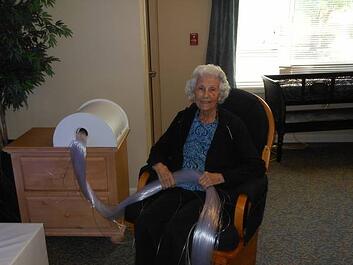
If you’ve never heard of the Dutch term Snoezelen (pronounced “snuzelen”), formed by the words “sniff and doze,” you’re probably not alone! Snoezelen is a type of therapy originally founded in Holland for individuals with cognitive and developmental disabilities.
A Snoezelen Room is a therapeutic environment created for the express purpose of delivering high levels of stimuli to patients with dementia. A private room displays optical illusions with combined lighting effects, aromas, colors, textures and sounds to stimulate a person’s olfactory, auditory and gustatory systems.
A Snoezelen Room is often used for Alzheimer’s and dementia care, and its reputation as a safe, mood-enhancing environment is catching on in several leading-edge assisted living communities. Some of the benefits of using this form of therapy are provided:
1. Increased Resident and Caregiver Communication
One of the key benefits of this therapy is its ability to reduce an individual's fears and enhance their trust in the people closest to them. Snoezelen can be specially adapted to meet the needs of the individual, delivering stimuli to seven of the senses (which include the vestibular for balance and proprioception for body part awareness). The environment facilitates better communication (both verbal and non-verbal) during and after therapy and is thought to deepen the relationship shared between caregivers and the individuals receiving care.
2. Increased Knowledge and Understanding of the Environment
In a controlled multi-sensory environment, patients receive a steady stream of stimuli that automatically increases their awareness (autonomous discovery) and understanding of their surroundings. The average person touches 300 different surfaces every 30 minutes; however, someone with profound dementia may average out at only three (3) different surface touches in 30 minutes. This shows in magnitude just how sensory-deprived many Alzheimer’s patients are and the benefits of clinically engaging their senses during senior care.
3. Improved Behavior and Mood
Sensory therapy has proven effective in calming aggressive behavior and improving mood. It is believed that this non-threatening environment offers gentle stimulation that reduces tension (Snoezelen settings include dimmed lighting, intriguing aromas, and soothing sounds), replenishes the spirit, and allows recuperation. Snoezelen has been used as an effective “Sundowners” intervention and for treating other Alzheimer’s manifestations.
4. Improved Self-Esteem
The benefits of Snoezelen may differ between each person but may include improved self-esteem. The rationale is that with an elevated sense of awareness (of both self and the environment) coupled with reduced inhibitions; candidates often display a sense of self-acceptance. A small research study also claims a 75% reduction in self-injury.
Note: Clients suffering from other non-Alzheimer/dementia symptoms (that is, bipolar and schizophrenia) are excluded from this type of therapy, so too, are patients who suffer from epilepsy.
Key Takeaways:
- A Snoezelen Room is a therapeutic environment created for the express purpose of delivering high levels of stimuli in patients with dementia.
- Sensory therapy has helped to reduce the fears of participants and enhance their trust in the people closest to them.
- With a steady stream of stimuli participants’ autonomic response increases along with an awareness of their surroundings.
- Sensory therapy has proven effective in calming aggressive behavior and improving mood.
- The benefits of Snoezelen may include improved self-esteem.
Learn More
If you are interested in learning more about Alzheimer's care to learn more about our Memory Care Services or contact us. We would love to further assist you.

